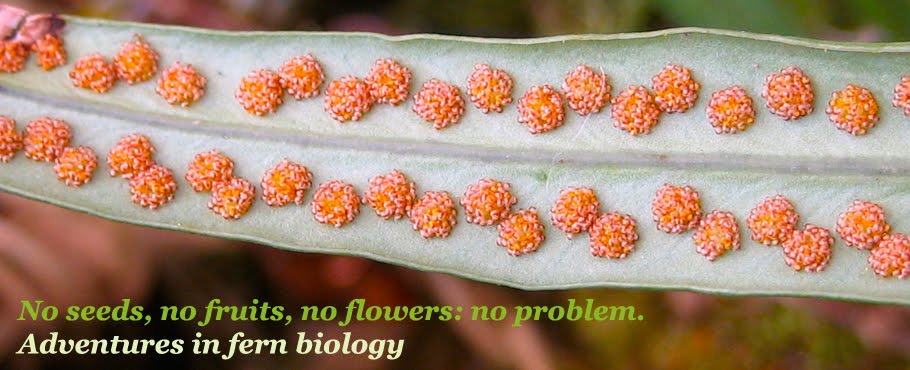Sunday, March 30, 2014
Talk at Botany 2014
Tuesday, March 25, 2014
A slew of fern gametophytes
Our spore growing efforts are really paying off! The species we're growing are from a variety of sources, including the Royal Botanic Garden Edinburgh, the greenhouses at Colgate University, and the Duke University herbarium. The latter have proven a little challenging – it's difficult to collect viable spores from herbarium sheets! But we're having success with a number of species in many different families, and it's very interesting to see their various morphologies and growth rates. Quite a few have produced eggs and sperm, found mates (not hard on the crowded petri plates) and made new sporophytes. For the actual experiments, we're moving them to separate plates long before they develop reproductive capacity, so that we can determine whether they're able to self or must have another gametophyte to mate with.
Have a look at some of what we've got growing:
 |
| Ceratopteris richardii |
 |
| Davallia pentaphylla |
 |
| Davallia pentaphylla |
 |
| Notholaena californica, already producing farina in the gametophytes and young sporophytes |
 |
| Notholaena californica |
 |
| Pellaea sp., hard to see the gametophytes because of the little sporophytes! |
 |
| Pityrogramma calomelanos |
 |
| Thelypteris sp., with healthy young sporophytes |
Sunday, March 23, 2014
180 million year old fern fossil discovered
 |
| Photo from the Science paper, credit: Benjamin Bomfleur |
It has long been known that modern members of Osmundales don't vary much morphologically compared to ancient forms – fossilized members of the order dating to the early Mesozoic (ca. 220 million years ago) are remarkably similar in several aspects of their morphology to modern species. The new fossil goes a step further: it contains intact cells, and even individual chromosomes, that the researchers were able to visualize with various types of microscopy. The fossil species had the same number of chromosomes and roughly the same predicted DNA content in the nucleus as modern cinnamon fern. This suggests that the lineage has not experienced significant upheaval in DNA content, through whole-genome duplication (polyploidy) or extensive gene loss, in the last 180 million years. The authors note that to date, most of what we know about ancient fern genome size is due to extrapolation from living taxa; this new fossil has permitted the first direct observations of paleo-DNA content in a fern.
Coverage of the new fossil online:
- From Lund University
- From Phys.org
The paper (requires a subscription): Bomfleur, B., S. McLoughlin, and V. Vajda. 2014. Fossilized nuclei and chromosomes reveal 180 million years of genomic stasis in royal ferns. Science 343: 1376–1377.
If you want to read more about relationships of Osmundales (also requires a subscription): Metzgar, J.S., J.E. Skog, E.A. Zimmer, and K.M. Pryer. 2008. The paraphyly of Osmunda is confirmed by phylogenetic analyses of seven plastid loci. Systematic Botany 33: 31-36.
 |
| Osmundastrum cinnamomea |
 |
| Osmunda regalis |
 |
| Osmunda claytoniana |
Saturday, March 15, 2014
UF campus plants, part V
More photos from walks around the UF campus with Walt Judd (see part I for more information). This walk was on March 13, 2014 at UF's Natural Area Teaching Lab.
 |
| Acer negundo |
 | ||
Quercus nigra
|
 |
| Thelypteris sp. |
 |
| Rumex crispus |
 |
| Rumex crispus |
 |
| Prunus caroliniana |
 |
| Pinus sp. |
 |
| Rubus trivialis |
 |
| Stachys floridana |
 |
| Tradescantia ohioensis |
Sunday, March 9, 2014
Trip to Helsinki, Finland
 |
| Kaisaniemi Botanic Garden at Luomos, the Finnish Museum of Natural History |
 |
| The entrance to the herbarium |
 |
| Beautiful wooden cabinets |
 |
| Carvings on each of the doors (not necessarily representative of the plants inside...) |
 |
| Henry, Aino, and me |
 |
| Sorry vegetarians, but there were lots of delicious sausages to be had... |
 |
| A sunny day! |
 |
| Main University of Helsinki building |
 |
| Finnish Museum of Natural History |
 |
| Finnish National Theater |
 |
| Waterfront |
 |
| Senate Square |
 |
| Helsinki Cathedral |
 |
| Statue of Alexander II, who established the Diet of Finland in 1863. |
Labels:
botanical gardens,
Dryopteris,
fern people,
field trips
Subscribe to:
Comments (Atom)








